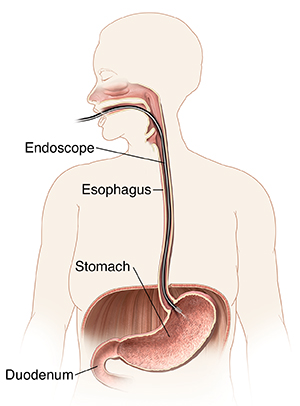Pediatric Upper GI Endoscopy

An upper GI endoscopy lets your child's provider look right into the beginning of their gastrointestinal (GI) tract. This area includes the esophagus, stomach, and the first part of the small intestine (the duodenum).
Before the test
Help your child follow these and any other instructions you're given before the endoscopy. If your child doesn't follow their provider’s instructions carefully, the test may need to be canceled or done over:
- Don't allow your child to eat or drink anything after midnight the night before the exam. If the exam is in the afternoon, allow only clear liquids in the morning, but don't allow food or drink for 8 hours before the exam. In some cases, you may be able to take medicines with sips of water until 2 hours before the procedure. Speak with your healthcare provider about this.
- Bring X-rays and any other test results you have.
- Tell your healthcare provider before the exam if your child is taking any medicines or has any medical problems.
The procedure
What to expect:
-
Your child will lie on the endoscopy table. Usually patients lie on the left side.
-
Your child will be monitored and given oxygen.
-
Your child will receive medicines through an IV line. These medicines will help them relax and stay comfortable. They may be awake or asleep during the procedure.
-
The healthcare provider will put the endoscope in your child's mouth and down their esophagus. It is thinner than most pieces of food that are swallowed. It will not affect your child's breathing.
-
Air is put into your child’s GI tract to expand it. It can make them burp or pass gas.
During the procedure, your child's provider will take biopsies (tissue samples), remove abnormalities, such as polyps, or treat abnormalities through a variety of devices placed through the endoscope. Your child will not feel this.
The endoscope sends images of your child's upper GI tract to a video screen.
When to call your child's provider
Call your child's provider if they have:
-
Black or tarry stools, or blood in their stool
-
Fever
-
Pain in their belly that does not go away
-
Upset stomach and vomiting, or vomiting blood